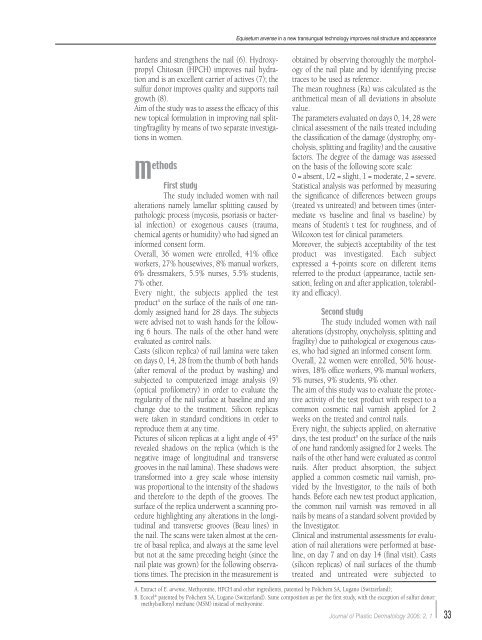Aprile Vol.2 N° 1 - 2006 - Salute per tutti
Aprile Vol.2 N° 1 - 2006 - Salute per tutti
Aprile Vol.2 N° 1 - 2006 - Salute per tutti
You also want an ePaper? Increase the reach of your titles
YUMPU automatically turns print PDFs into web optimized ePapers that Google loves.
hardens and strengthens the nail (6). Hydroxypropyl<br />
Chitosan (HPCH) improves nail hydration<br />
and is an excellent carrier of actives (7); the<br />
sulfur donor improves quality and supports nail<br />
growth (8).<br />
Aim of the study was to assess the efficacy of this<br />
new topical formulation in improving nail splitting/fragility<br />
by means of two separate investigations<br />
in women.<br />
M ethods<br />
First study<br />
The study included women with nail<br />
alterations namely lamellar splitting caused by<br />
pathologic process (mycosis, psoriasis or bacterial<br />
infection) or exogenous causes (trauma,<br />
chemical agents or humidity) who had signed an<br />
informed consent form.<br />
Overall, 36 women were enrolled, 41% office<br />
workers, 27% housewives, 8% manual workers,<br />
6% dressmakers, 5.5% nurses, 5.5% students,<br />
7% other.<br />
Every night, the subjects applied the test<br />
productA on the surface of the nails of one randomly<br />
assigned hand for 28 days. The subjects<br />
were advised not to wash hands for the following<br />
6 hours. The nails of the other hand were<br />
evaluated as control nails.<br />
Casts (silicon replica) of nail lamina were taken<br />
on days 0, 14, 28 from the thumb of both hands<br />
(after removal of the product by washing) and<br />
subjected to computerized image analysis (9)<br />
(optical profilometry) in order to evaluate the<br />
regularity of the nail surface at baseline and any<br />
change due to the treatment. Silicon replicas<br />
were taken in standard conditions in order to<br />
reproduce them at any time.<br />
Pictures of silicon replicas at a light angle of 45°<br />
revealed shadows on the replica (which is the<br />
negative image of longitudinal and transverse<br />
grooves in the nail lamina). These shadows were<br />
transformed into a grey scale whose intensity<br />
was proportional to the intensity of the shadows<br />
and therefore to the depth of the grooves. The<br />
surface of the replica underwent a scanning procedure<br />
highlighting any alterations in the longitudinal<br />
and transverse grooves (Beau lines) in<br />
the nail. The scans were taken almost at the centre<br />
of basal replica, and always at the same level<br />
but not at the same preceding height (since the<br />
nail plate was grown) for the following observations<br />
times. The precision in the measurement is<br />
Equisetum arvense in a new transungual technology improves nail structure and appearance<br />
obtained by observing thoroughly the morphology<br />
of the nail plate and by identifying precise<br />
traces to be used as reference.<br />
The mean roughness (Ra) was calculated as the<br />
arithmetical mean of all deviations in absolute<br />
value.<br />
The parameters evaluated on days 0, 14, 28 were<br />
clinical assessment of the nails treated including<br />
the classification of the damage (dystrophy, onycholysis,<br />
splitting and fragility) and the causative<br />
factors. The degree of the damage was assessed<br />
on the basis of the following score scale:<br />
0 = absent, 1/2 = slight, 1 = moderate, 2 = severe.<br />
Statistical analysis was <strong>per</strong>formed by measuring<br />
the significance of differences between groups<br />
(treated vs untreated) and between times (intermediate<br />
vs baseline and final vs baseline) by<br />
means of Student’s t test for roughness, and of<br />
Wilcoxon test for clinical parameters.<br />
Moreover, the subject’s acceptability of the test<br />
product was investigated. Each subject<br />
expressed a 4-points score on different items<br />
referred to the product (appearance, tactile sensation,<br />
feeling on and after application, tolerability<br />
and efficacy).<br />
Second study<br />
The study included women with nail<br />
alterations (dystrophy, onycholysis, splitting and<br />
fragility) due to pathological or exogenous causes,<br />
who had signed an informed consent form.<br />
Overall, 22 women were enrolled, 50% housewives,<br />
18% office workers, 9% manual workers,<br />
5% nurses, 9% students, 9% other.<br />
The aim of this study was to evaluate the protective<br />
activity of the test product with respect to a<br />
common cosmetic nail varnish applied for 2<br />
weeks on the treated and control nails.<br />
Every night, the subjects applied, on alternative<br />
days, the test product B on the surface of the nails<br />
of one hand randomly assigned for 2 weeks. The<br />
nails of the other hand were evaluated as control<br />
nails. After product absorption, the subject<br />
applied a common cosmetic nail varnish, provided<br />
by the Investigator, to the nails of both<br />
hands. Before each new test product application,<br />
the common nail varnish was removed in all<br />
nails by means of a standard solvent provided by<br />
the Investigator.<br />
Clinical and instrumental assessments for evaluation<br />
of nail alterations were <strong>per</strong>formed at baseline,<br />
on day 7 and on day 14 (final visit). Casts<br />
(silicon replicas) of nail surfaces of the thumb<br />
treated and untreated were subjected to<br />
A. Extract of E. arvense, Methyonine, HPCH and other ingredients, patented by Polichem SA, Lugano (Switzerland);<br />
B. Ecocel<br />
Journal of Plastic Dermatology <strong>2006</strong>; 2, 1 33<br />
® patented by Polichem SA, Lugano (Switzerland). Same composition as <strong>per</strong> the first study, with the exception of sulfur donor:<br />
methylsulfonyl methane (MSM) instead of methyonine.

















